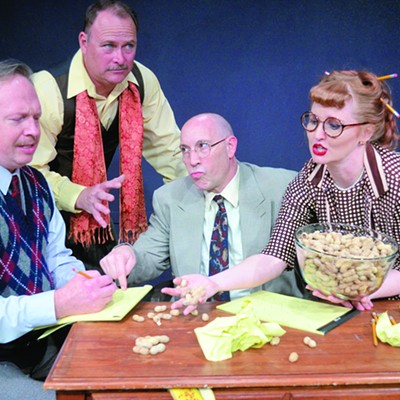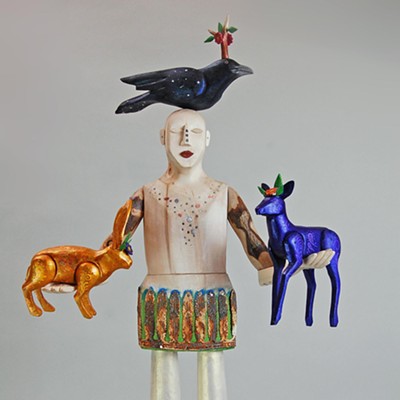Happy V-Day
The Vagina Monologues: V-Day Edition6:30 p.m., Friday, Feb. 18, and Friday, Feb. 25
Club Congress
311 E. Congress St.
444-9281; www.vdaytucson.org
What started as a play in the basement of a downtown New York City café nine years ago has evolved into an international phenomenon; Eve Ensler's Vagina Monologues--published by Villard Books/Random House two years after Ensler's first performance, complete with forward by Gloria Steinem--has since been translated into more than 24 different languages and been interpreted on stage by women such as Glenn Close, Calista Flockhart, Jane Fonda, Melissa Etheridge and Oprah Winfrey.
But celebrities aren't what propelled Ensler's work to meaningfulness; the fact that Vagina Monologues encompasses the lives and experiences of a dizzying range of individual women--and thus says something important about what we share--has made it resonant and powerful enough to spawn a furious grassroots movement called "V-Day"--a global campaign to stop violence against women and girls.
V-Day is particularly cool because although the movement itself is international, once the women of any given city decide to create a V-Day event, the focus narrows instantly to those organizations within a community that need help to continue helping women. Most of the proceeds of V-Day Tucson's two performances of The Vagina Monologues will benefit the rape prevention efforts of the Southern Arizona Center Against Sexual Assault, with the remaining 10 percent going to The Organization for Women's Freedom in Iraq.
To learn more about V-Day Tucson, call the number above; for additional information about the event, call Club Congress at 622-8848.
Support TPF; See Sherman
Sherman Alexie appearances for Tucson Poetry FestivalVarious times, Feb. 17-19
Various locations
620-2045
The Tucson Poetry Festival makes no claim to robust health. "Like many cultural treasures and arts organizations," their press release reads, "TPF is continuing the 23-year struggle to sustain itself." As part of this year's fund-raising efforts, author, poet and filmmaker Sherman Alexie has donated several days of his time to making a series of appearances, the proceeds of which will benefit the TPF.
Alexie is a stunning example of what a true storyteller can do, having made successful forays into novels, short stories, poetry, screenplays and even directing. The Los Angeles Times declared that The Business of Fancydancing--a film Alexie wrote and directed--"bristles with a passion and intelligence," and Smoke Signals, with screenplay by Alexie, won the 1998 Sundance Film Festival Audience Award, becoming the first film written, directed and acted by Native Americans to score both commercial and critical success.
The Business of Fancydancing will screen at 7:30 p.m. Thursday, Feb. 17 at the Screening Room (127 E. Congress St.), followed by a Q&A with Alexie; tickets are $10 at the door (cash only). Alexie will join attendees of the "Flavor of Mexico" buffet from noon to 2 p.m. Friday, Feb. 18, at Desert Diamond Casino (Interstate 19 and Pima Mine Road); tickets are $25-$32. A "reading/performance" by Alexie will take place at 7:30 p.m. Friday, Feb. 18, at Tucson High Magnet School (Sixth Street and Second Avenue); tickets are $10-$16. A breakfast Q&A with Alexie is scheduled for 10 a.m. to noon Saturday, Feb. 19, at the Café at the Temple of Music and Art (330 S. Scott St.); tickets are $20-$25. Call the above number for additional information.
Tales of Two Places
Iraq's Cultural Heritage Under Occupation--lecture; 'The Sights And Sounds Of The Arctic Wildlife Refuge'--presentationVarious dates
Various locations
At first glance, the issues surrounding Iraq and the native people of the Arctic Wildlife Refuge couldn't be more different, but at second glance ... well, they're still totally different. But what those cultures share is vitally important--they're currently occupied and being forced to change traditional ways of doing and thinking about things, because they've come in contact with a culture that overwhelms by virtue of sheer numbers and "superior technology." (Interestingly, the needs of said technology--oil, for example--often have a lot to do with why those cultures were bothered in the first place.)
While the current occupation of Iraq is making headlines, it isn't the first time the area has been invaded and occupied. Professor Zainab Bahrani--a professor of ancient Near Eastern art history and archaeology at Columbia University--will present Mesopotamia as Battleground: Iraq's Cultural Heritage Under Occupation at 7 p.m. Thursday, Feb. 24. Bahrani was born in Baghdad and educated in Europe and the United States; she was previously a professor at the University of Vienna in Austria and a curator in the Metropolitan Museum of Art's Near Eastern Antiquities Department. The lecture is free and open to the public; call 626-3846 for additional information.
Ken Madsen, a writer and photographer whose work has been shown on the Discovery Channel, spent six years working to protect the Arctic Wildlife Refuge; his multimedia presentation about the refuge will run from 7 to 8:30 p.m. Thursday, Feb. 17 and feature William Greenland, a member of the Gwich'in tribe--those people native to the area. The event is free and open to the public; call 626-0360 for additional information.
Now Appearing in a Glass Box Near You
Silent Echoes Mime Theatre 8 p.m., Friday and Saturday, Feb. 18 and 19; 2 and 7 p.m., Sunday, Feb. 20ZUZI Little Theater
738 N. Fifth Ave.
990-7425
The Emperor Augustus of Rome loved mimes; the Church excommunicated them. But through good times and bad, whether considered negligible slapstick, intelligent social commentary or moralistic high art, mime itself lived on.
The ancient Greeks--as many as 10,000 at a time--watched mimes perform in Athens' Theater of Dionysus; when the Romans conquered Greece, they took mime back to Italy and made it their own, dubbing it Commedia dell'Arte as it reached its peak in the 16th century. Traveling mime troupes roamed Europe, unhindered by language barriers, and found particular adoration in France, where many of the traditional gestures and characters (such as Harlequin) were cemented.
Modern mime's greatest boost came in the early 1800s, when Jean Gaspard Batiste Deburau--son of an acrobatic Bohemian family--rescued mime from the slapstick form it had receded into by creating the character of lovesick Pierrot--the eternal seeker. Post-World War I saw the emergence of the great Jacques Copeau, who taught mime luminaries such as Etienne Decroux, who in turn went on to mentor Marcel Marceau, who--influenced by the day's silent film starts such as Chaplin and Keaton--created the "Bip" character that mime fans know and love, top hat, flower and all.
Modern mime in America is as much a melting pot of styles and tenants as every other art and idea in this country is--just ask mimes Eg Mahan, Denis Schaller and Stephen Chipps, who will perform in Tucson's Theatrical Mime Theatre season opener this week ... not that they'll answer.
Tickets to the show are $12.







